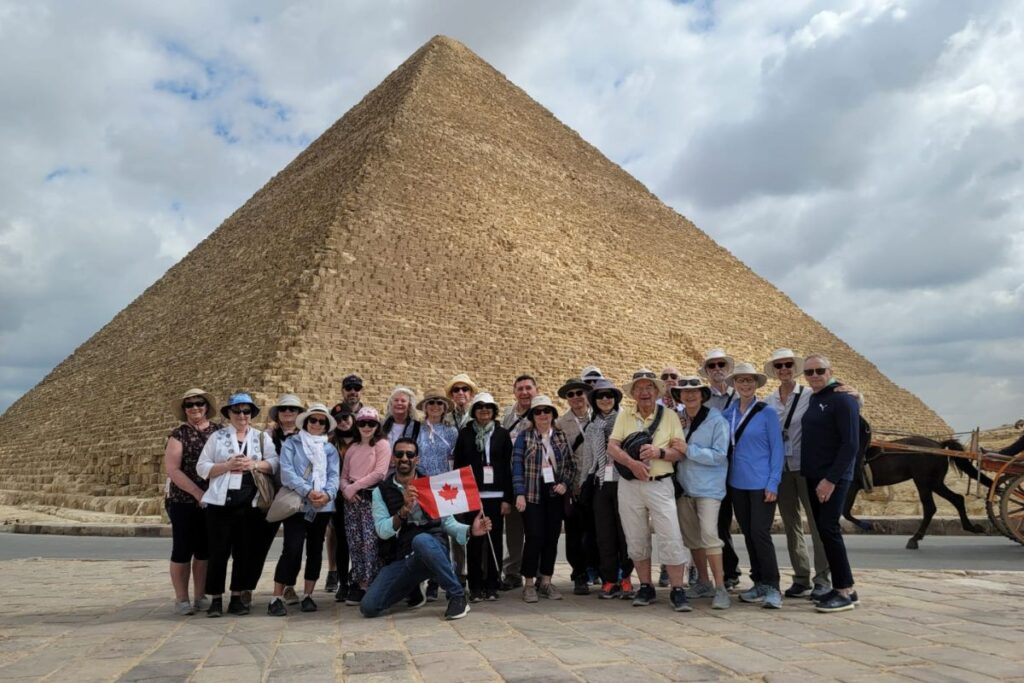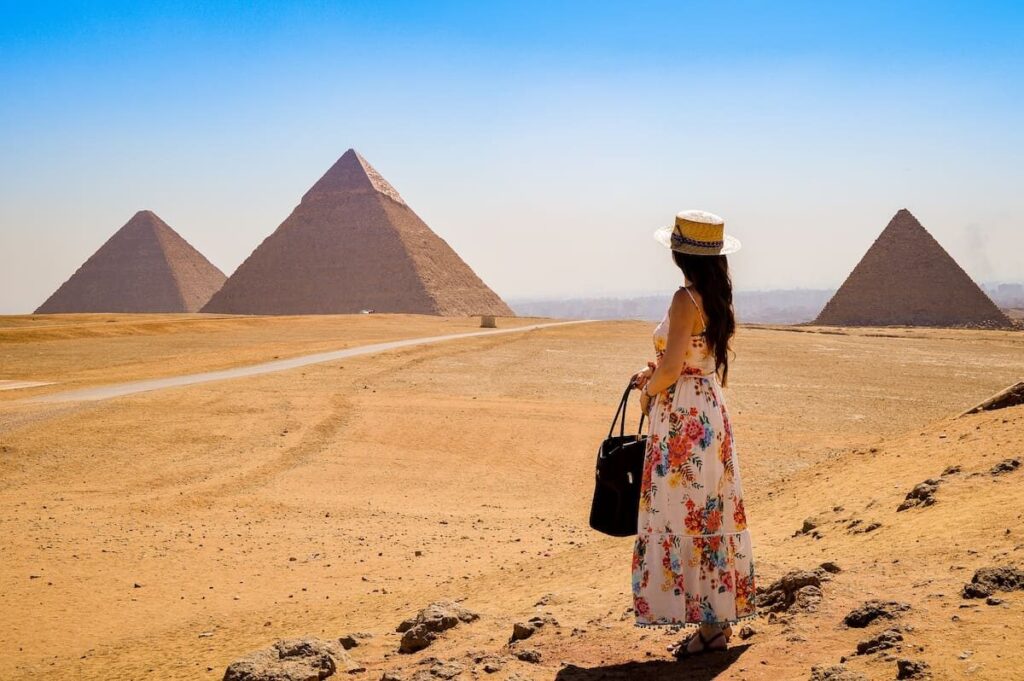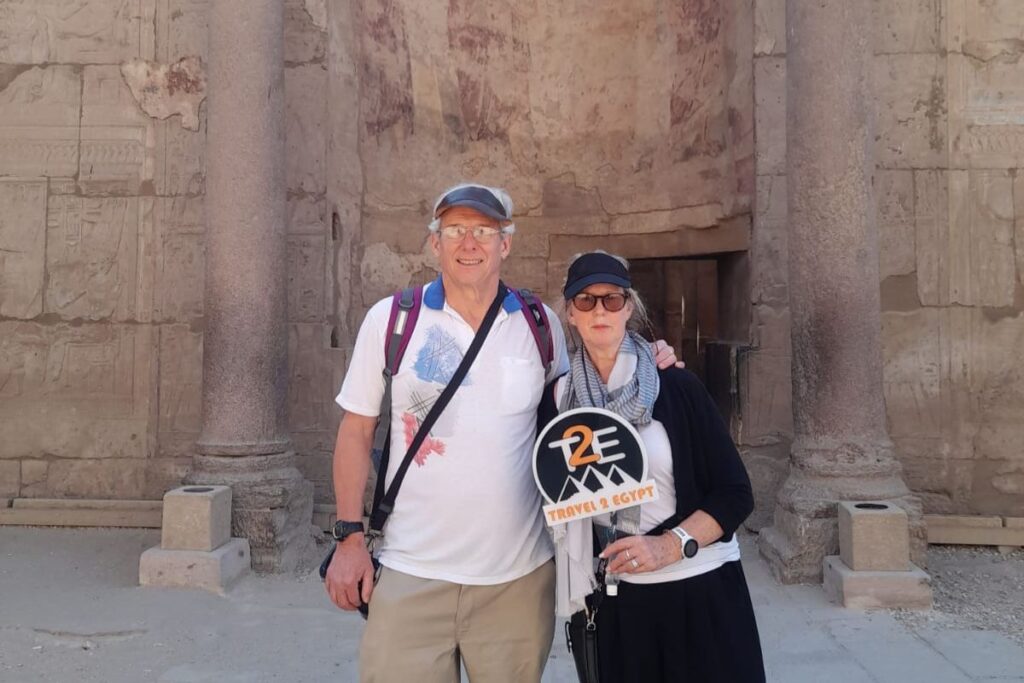“How to Dress When Visiting Egypt?” is a question many travelers ask before embarking on their adventure to this culturally rich and sun-drenched land. Dressing appropriately in Egypt goes beyond comfort—it’s a meaningful way to show respect for local traditions and ensure you blend seamlessly into the vibrant tapestry of daily life.
On my first trip, figuring out what to pack was a mix of excitement and uncertainty. I quickly realized that understanding how to dress well in Egypt wasn’t just about beating the heat but about honoring a culture where modesty and style go hand in hand. Whether you’re exploring bustling markets, ancient temples, or sacred mosques, this guide will help both men and women navigate Egypt’s unique blend of climate, culture, and dress codes with confidence and ease.
1. Understanding Egypt’s Cultural Context
Egypt is a country where tradition and modernity coexist, but modesty remains a cornerstone of everyday life—especially when it comes to clothing. The majority of Egyptians follow Islamic customs, which encourage dressing modestly as a sign of respect and dignity.
Think of clothing here as a language—a way to communicate respect without saying a word. While tourist hotspots are often more relaxed, venturing into rural areas or religious sites calls for more conservative choices. For women, this often means covering shoulders and knees; for men, avoiding overly casual or revealing attire is appreciated.
Dressing modestly isn’t about limiting your style; it’s about embracing a different cultural rhythm. It’s like tuning into the local music—once you understand the beat, you can dance along beautifully.

2. Weather and Climate Considerations
Egypt’s climate is famously hot and dry, especially during the long summer months when the sun feels like a constant companion. Imagine walking through Cairo’s streets with the sun beating down—a lightweight, breathable outfit quickly becomes your best friend.
On my first visit during July, I quickly learned that cotton and linen are more than fabric choices—they’re survival tools. These materials let your skin breathe, keeping you cool while also providing coverage from the sun’s intense rays. Wearing dark, heavy clothing? That’s like inviting the desert sun to sit right on your shoulders.
Sun protection is a must. Hats with wide brims, sunglasses, and scarves serve double duty: shielding you from the sun and helping you blend into the cultural landscape. In the evenings, temperatures can dip surprisingly low, especially in desert regions like Luxor or Aswan, so packing a light jacket or shawl can keep you comfortable as you explore ancient ruins under a cooler sky.
Layering is key. Think of it as dressing in Egyptian style armor against the sun’s fiery arrows by day and the cool desert winds by night. This practical approach keeps you comfortable without sacrificing cultural respect.
3. Dressing Tips for Women
For women visiting Egypt, dressing is a balancing act between comfort, cultural respect, and personal style. I recall wandering through Cairo’s vibrant Khan El Khalili market wearing lightweight, loose-fitting pants and a long-sleeved blouse—it kept me cool yet modest enough to blend comfortably with the locals.
The key is modesty: clothing that covers your shoulders and knees is generally recommended, especially when visiting religious sites or rural areas. Long skirts, maxi dresses, and loose pants made of breathable fabrics like cotton or linen are perfect companions for your Egyptian adventure.
Many women choose to carry a lightweight scarf, not necessarily to cover their heads all the time, but as a versatile accessory. In mosques, wearing a headscarf is a respectful gesture, and the same scarf can double as sun protection while exploring the sun-drenched streets.
Footwear matters too. Comfortable, closed-toe shoes or sturdy sandals are best—think of the cobblestones, sand, and sometimes uneven surfaces you’ll encounter. On my trip, a pair of cushioned walking sandals saved me from blistered feet and let me roam the ancient streets with ease.
Avoid tight, revealing, or transparent clothing—it’s not just about local customs but also about feeling comfortable amid Egypt’s bustling crowds. Dressing thoughtfully opens doors, literally and figuratively, making your journey smoother and more enjoyable.

4. Dressing Tips for Men
Men visiting Egypt also need to find the sweet spot between comfort, respect, and practicality. During my first trip, I found that lightweight trousers or long shorts paired with loose cotton or linen shirts were my go-to. These choices kept me cool under the blazing sun while respecting the local preference for modest dress.
Sleeveless tops or tank tops are generally best avoided, especially in conservative areas and religious sites, as they can be seen as too casual or disrespectful. Instead, opt for short- or long-sleeved shirts that allow airflow but also cover the shoulders.
Comfortable footwear is a must. Walking shoes or sandals with good support help you navigate Cairo’s mix of smooth pavements, bustling markets, and uneven ancient ruins. On my walks through Islamic Cairo, sturdy closed shoes kept my feet safe and comfortable over hours of exploration.
A wide-brimmed hat or cap can be a lifesaver under the intense Egyptian sun, and carrying a lightweight scarf or bandana adds a handy layer for extra sun protection or unexpected dust.
Dressing thoughtfully not only helps you stay comfortable but also earns respect, making interactions with locals warmer and more welcoming—a key part of any memorable trip.

5. Special Considerations for Visiting Religious Sites
Visiting Egypt’s magnificent mosques, churches, and temples is a highlight for many travelers—but these sacred spaces come with specific dress codes that reflect centuries of reverence and tradition.
I remember my visit to the Sultan Hassan Mosque in Cairo—before entering, I had to adjust my scarf to cover my hair properly and pull down my sleeves to ensure my shoulders were covered. This simple act of respect opened doors, literally and figuratively, allowing me to fully appreciate the serene beauty inside.
For women, covering shoulders and knees is essential, and wearing a headscarf is often required in mosques. Carrying a lightweight scarf in your bag is a smart move—you can easily slip it on when needed without disrupting your entire outfit.
Men should avoid sleeveless shirts and opt for long pants or modest shorts. Removing shoes before entering many religious sites is customary, so wearing shoes that are easy to take off and put on saves time and hassle.
Respecting these dress codes isn’t about strict rules; it’s about honoring the sacredness of these places and the people who gather there. Dressing appropriately enhances your experience, showing humility and openness that locals deeply appreciate.
6. Packing Essentials and Style Tips
Packing for Egypt means preparing for a journey where style meets functionality and respect. Think of your suitcase as your travel toolkit—each item chosen to keep you comfortable, culturally aware, and ready for anything.
Versatile clothing pieces are your best friends. Items like loose pants, long skirts, and lightweight tops can be mixed and matched easily, helping you travel light without sacrificing style or modesty. Fabrics like cotton, linen, and moisture-wicking blends work wonders in the heat.
Scarves are travel heroes—they serve as sun protection, modesty covers, and even light shawls when the temperature dips. Bring a few in neutral colors to complement different outfits effortlessly.
Comfortable walking shoes or sandals are essential, given the mix of city pavements and historic sites you’ll explore. I always pack an extra pair of shoes in case one gets dusty or wet.
Don’t forget essentials like a wide-brimmed hat, sunglasses, and sunscreen—they’re your frontline defense against Egypt’s strong sun. And if you’re traveling in winter or visiting desert areas, a lightweight jacket or cardigan will keep you cozy after sunset.
Remember, laundry facilities are available in most hotels and guesthouses, so packing fewer clothes to wash along the way is a smart choice. With thoughtful packing, you’ll stay comfortable, respectful, and stylish throughout your Egyptian adventure.
Conclusion
Dressing thoughtfully when visiting Egypt is more than just a practical choice—it’s a way to connect deeply with a culture steeped in tradition, respect, and hospitality. By embracing modest, comfortable, and climate-appropriate clothing, both men and women can navigate Egypt’s vibrant streets, historic sites, and sacred spaces with confidence and ease.
Remember, the right outfit is like a bridge—it opens doors to richer experiences, welcoming smiles, and memorable interactions. Whether you’re exploring bustling markets, ancient temples, or peaceful mosques, dressing well enriches your journey and honors the beautiful culture you’re discovering.
So pack smart, dress respectfully, and get ready to immerse yourself in the timeless magic of Egypt—with every step feeling both comfortable and connected.
FAQ: How to Dress When Visiting Egypt
1. Do I have to dress modestly when visiting Egypt?1. Do I have to dress modestly when visiting Egypt?
Yes. While Egypt is relatively tolerant in tourist areas, modest clothing is appreciated across the country. Covering shoulders, cleavage, and knees is recommended for both men and women, especially in religious sites or rural areas.
2. What should women wear when visiting Egypt?
- Loose-fitting clothing that covers shoulders and knees
- Maxi dresses, long skirts, or loose pants made of breathable fabrics
- Lightweight scarves for sun protection and mosque visits
- Comfortable closed shoes or walking sandals for uneven streets
Revealing, tight, or sheer clothing is best avoided in public spaces.
3. What should men wear when visiting Egypt?
- Lightweight trousers or long shorts
- Loose cotton or linen shirts (short- or long-sleeved)
- Comfortable walking shoes or sandals
- A sun hat or cap for protection
Sleeveless tops and tank tops are best avoided in religious or conservative areas.
oli but the Little Blind Text didn’t listen. She packed her seven versalia, put her initial into the belt and made herself on the way.4. Is there a dress code for visiting mosques and religious sites?
Yes. Visitors should dress respectfully:
- Women: Cover arms, legs, and hair with a scarf; loose clothing is best.
- Men: Wear long pants and avoid sleeveless tops.
- Both: Remove shoes before entering mosques.
5. What fabrics are best for Egypt’s climate?
Natural and breathable fabrics like cotton, linen, and moisture-wicking blends are ideal. They help you stay cool and comfortable in the heat while also providing sun protection.
6. Do I need to pack a scarf?
Yes. Scarves are incredibly versatile—they can be used for sun protection, to cover your head in mosques, or as a light layer during cooler evenings. Bring at least one neutral-colored scarf that pairs easily with your outfits.
7. What kind of shoes should I bring?
Comfortable walking shoes or sturdy sandals with good grip are a must. Many historic sites have uneven terrain, so prioritize support over fashion. Consider packing a second pair in case one gets dusty or worn.
8. What should I wear in Egypt during the winter?
Winters can be cool—especially in desert areas. Bring a light jacket, cardigan, or scarf for layering in the evenings. During the day, you can still wear breathable layers, but don’t underestimate the chilly breeze after sunset.
9. Can I wear swimwear at the beach or pool?
Yes, swimwear is fine at resorts, hotel pools, and beaches. However, bikinis are best reserved for private resort areas. Outside those zones, more modest swimwear (or a cover-up) is advisable, especially in public beaches or local towns.
10. What are some packing essentials for Egypt?
- Loose, breathable clothing (cotton or linen)
- Scarf or shawl
- Comfortable shoes or sandals
- Sunglasses, sunscreen, and a wide-brimmed hat
- Light jacket for cooler evenings or winter travel
Think layers and comfort, and pack lighter—you can always do laundry during your trip.






